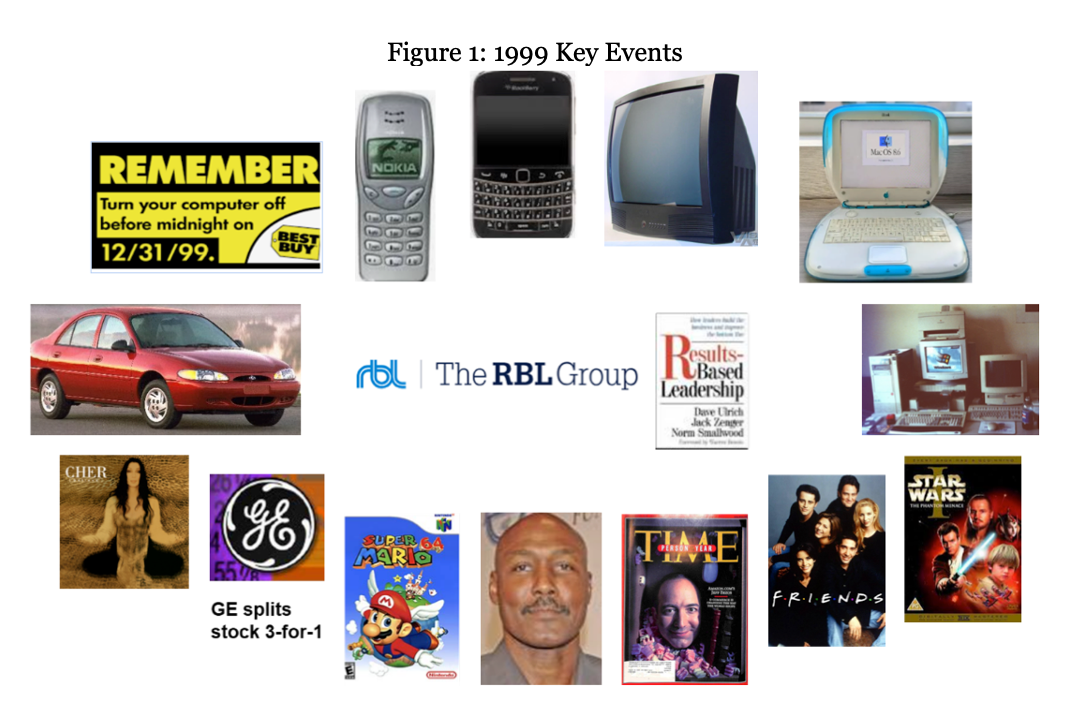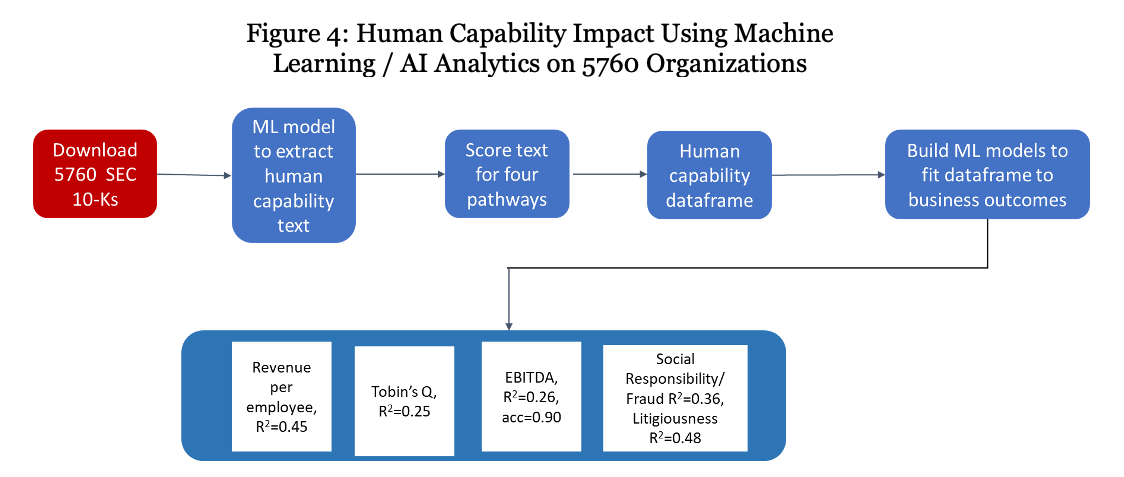Celebrating the HR Agenda Over 25 Years
Key Takeaways:
- Over 25 years, HR has shifted its focus from being action-oriented to results-based, advocating an integrated approach called "human capability" with 38 initiatives in talent, leadership, organization, and HR pathways.
- RBL derives data-driven insights based on global research to inform decision-making. The use of AI and machine learning to measure human capability's impact on business outcomes is essential for HR's evolution.
- From analyzing and upgrading HR functions to exploring the future role of AI and technology, RBL's seasoned consultants are committed to ongoing evolution, adaptability, and progress.

Celebrating the HR Agenda Over 25 Years

Where were you and what were you doing in 1999? 25 years ago? How many of the images in Figure 1 do you recall? In addition to the memorable events in Figure 1, Norm Smallwood, Jack Zenger, and I published the book Results-Based Leadership, and Norm and I used the title to start The RBL Group. Norm had co-founded and then sold the Novations Group, and I had been a professor at the University of Michigan for seventeen years.
In 2024, we celebrate the 25th anniversary of The RBL Group (see picture of our remarkable team in the header of this article).
This post invites you to embrace our idea friends by sharing our RBL assumptions and insights (ideas, research, solutions) that have helped shape the still-continuing evolution of the human resource (HR) field.

Fundamental Assumptions
Our work draws on five fundamental assumptions.
1. Results matter. HR is less about HR work (policies, initiatives, or actions) and more about the value created for stakeholders from HR work. This outside-in, results-based view of HR emphasizes results over actions and deliverables over doables.
2. HR integration. Instead of isolated and independent HR initiatives, we advocate for an integrated and expanded view of HR that we call “human capability,” including 38 initiatives in the four defined pathways of talent + leadership + organization + HR pathways (Figure 2).
Figure 2: Overview of Human Capability: Four Pathways; 38 Initiatives

3. Rigorous analytics informs choices. We have based our work on large global research that provides empirical guidance (Figure 3) rather than relying on personal perceptions. In doing so, we strive to integrate and build on others’ good works.

4. Ideas with IMPACT. While we embrace ideas based on research, our insights are grounded in solutions that have sustainable impact—impact that is possible by closing the know-do gap. For example, we have articulated actionable insights for each of the 38 human capability initiatives in Figure 2.
With these assumptions, we can review what we have learned and explore what’s next for human capability overall and in each of the four human capability pathways.
Human Capability Overall
Using machine learning / AI data from 5700 publicly traded organizations, we demonstrated the impact of disclosed human capability investments on key business outcomes (Figure 4).
Going forward, we will be able to score any organization’s human capability based on all public disclosures (e.g., 10-K, proxy, ESG, earnings calls, social media) and internal documents (board meetings, CEO presentations) to determine the impact of their human capability efforts on desired business and stakeholder outcomes (see www.g3humancapability.com).

Human Capability: Talent
Talent is also known as workforce, employee, people, or individual competence. In the top left quadrant of Figure 5 (red), we highlight the work on talent advantage, which includes research on talent acceleration in Asian markets and exploration of why people work. In particular, we have explored: the importance of and tools required for acquiring talent, development and career opportunities, positive performance accountability, and retaining talent.
Looking ahead, we want to examine how to create a more positive employee work experience (be safe, believe, become, belong) by replacing feelings of helplessness with hopefulness. Hope increases when organizations manage expectations and when employees believe that their efforts lead to positive outcomes they care about (efficacy); they have optimism to see what is right more than wrong, and they seek new ways to approach and do work (reimagination).
Human Capability: Leadership at All Levels
In the top right (green) of Figure 5, we list five of our books on leadership. We have explored why leadership matters to all stakeholders, what good leadership looks like in terms of leadership competencies that reflect customer promises, and how to upgrade leadership. We have encouraged a focus not only on the individual leader but on the processes of building leadership capability throughout an organization.
As the five Leadership Code foundations remain stable, we have recently posted about some changes for effective first-line leaders, including focusing on future opportunities more than current circumstances, defining and navigating paradoxes or competing demands, and scaling personalization. Once effective leadership actions and behaviors are identified, leaders at all levels can identify and improve crucial competencies.
Human Capability: Organization
Organization is also known as workplace, team, culture, or capability. In the bottom right quadrant on Figure 5 (blue), we have summarized our studies found in ten books on reinventing how to understand organizations. We have been primary advocates of redefining organization as a set of differentiating capabilities that enable organizations to deliver value to all stakeholders instead of as a morphology, structure, or system. We have articulated how organizations audit and build capabilities—such as the right culture defined as identity in the marketplace, strategic clarity, agility/change, innovation, efficiency, and collaboration (boundaryless).
We envision even more work on transforming how organizations deliver capabilities. This work will evolve and combine work on agility and the right culture to explore the tools and skills for business, individual, and HR transformation. Transformation capability becomes even more essential in rapidly changing markets where the future is less predictable than the past.
Human Capability: Human Resource Function
Much of our work for the last 25 years has been analyzing and upgrading the HR function. We have evolved how to think about HR from a focus on administrative processes (personnel) to a focus on functional excellence in HR practices (e.g., staffing, training, compensation, communication, work design), then to human capital with a focus on individual talent, and finally to human capability as defined in Figure 2. Based on our research and others’ studies, we have identified ten dimensions of an effective HR department (purple and bottom left of Figure 5)—elaborated upon in fourteen of our books. Our research has shown that the relationships and how HR people work together and with others (item #10 in purple) has more impact on stakeholder value than the organization of the HR function (item #4). We also have documented with extensive data which HR competencies have the most impact on outcomes (item #9).
Looking forward, we know that AI and technology will continue to dramatically change how businesses and HR operates. We will examine how HR professionals can help craft and deliver a digital business strategy to turn artificial intelligence into augmented and informed intelligence to make better decisions. We will also explore (with many others) how AI will change and evolve HR practices.

(Not the) Conclusion
What an honor to work with incredible colleagues at RBL and elsewhere who jointly celebrate the last 25 years of progress in the HR field. Sharing our ideas, friends who we hope will outlast us and shape how people live, work, play, and worship is an even greater honor.
And we anticipate that the best is yet to come. Our fifth and most lasting assumption reflects the Churchill quote, “Now this is not the end. It is not even the beginning of the end. But it is, perhaps, the end of the beginning.”
The best is yet ahead! Please do not hesitate to contact us to discuss with our seasoned consultants how RBL can help build human capability that delivers business results throughout your organization.


